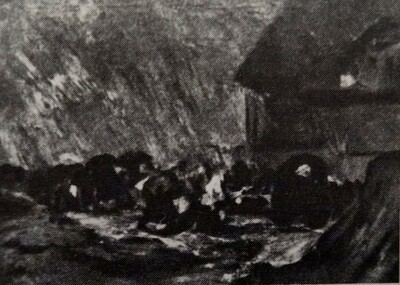- Cronología
- Ca. 1808 - 1812
- Ubicación
- Buenos Aries National Museum of Fine Arts, Buenos Aires, Argentina
- Dimensiones
- 72 x 99 cm
- Técnica y soporte
- Oil on canvas
- Reconocimiento de la autoría de Goya
- Undisputed work
- Titular
- National Museum of Fine Arts, Argentina
- Ficha: realización/revisión
- 16 May 2010 / 15 Jun 2023
- Inventario
- (2563)
X.28
The first information on these works was published by the Count de la Viñaza in 1887, who recorded them in the Madrid collection of Eustaquio López, which was sold in 1866. According to Juan Corradini (1965), in 1886 Miguel Cané, the Argentine ambassador to Spain, on the advice of the Duke of Alba, bought six paintings by Goya, including The Fire and War Scene, as well as Procession of Discipliners, commissioned by Gabriel Larsen del Castaño; Popular Feast, bought by Parmenio T. Piñero, and two paintings acquired by the Jockey Club of Buenos Aires.
In 1907, Popular Feast entered the Museum through the Piñero bequest. The remaining three were in the possession of the Ugarte family, who auctioned them in 1954, at which time doubts again arose as to their authorship. They were acquired by Horacio Acevedo with the intention of donating them to the MNBA, where they entered in 1958 by donation of his brothers Carlos Alberto, Arturo and Eduardo Acevedo.
Thanks to the inscription X.28 that appears on this canvas, it has been possible to identify this work and to attribute it to the artist, together with three others, Bandit Scene, Festivities underneath a Bridge and The Hurricane. This same reference appears in the inventory made by the notary following the death of Josefa Bayeu in 1812.
In the middle of a desolate landscape, a number of bandits open fire on a group of people. Standing out from this second group are two who are wearing white tunics, probably an allusion to their innocence. In the foreground, one of them has their arms flung out in the form of a cross. The other is standing further back and has his arms up in a gesture of surrender, like the protagonist in Third of May 1808. Threatening storm clouds fill the sky apart from in a small area in the centre, directly above the person dressed in white who is crying out for help, where a patch of blue sky is visible. The forces of nature are overwhelmingly predominant in this painting, dwarfing the human figures and ostensibly reducing their importance.
Goya employs another device here in Bandit Scene which we can also see in Third of May 1808 as well as in some of the etchings in the Disasters of War series: the faces of the executioners are hidden from view.
-
Greco, Velázquez, Goya. Spanische Malerei aus deutschen SammlungenBucerius Kunst ForumHamburg2005from May 18th to August 21st 2005. Displayed alto at the Staatliche Kunstsammlungen Dresden Gemäldegalerie Alte Meister, Dresde, September 17th 2005 to January 2nd 2006 and at the Szépmüvészeti Múzeum, Budapest, January 21st to April 30th 2006pp. 162-163, cat. 73
-
L'œuvre peint de Goya. 4 volsParís1928-1950p. 203, cat. 164
-
Vie et ouvre de Francisco de GoyaParísOffice du livre1970p. 265, cat. 948
-
BarcelonaPolígrafa1970vol. I, pp. 356 y 357, cat. 611
-
L’opera pittorica completa di GoyaMilanRizzoli1974p. 125, cat. 529



